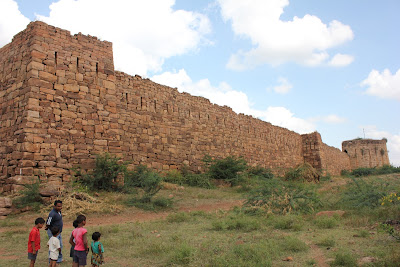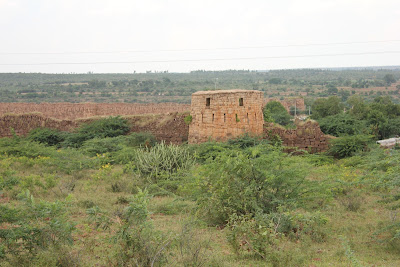
A - Flag bastion, close to Mudkavi bus-stand
B - main entrance and lake
C - inner fort's gateway
D - Maddinakoli ~ ammunition store in a bastion
E - temple and open well
F - Hanuman Mandir and Erannagudi
Main entrance of the fort.

Right next to the gateway are two temples. This is Hanuman temple.

Eranna temple. One of the villagers mentioned that the temple was in ruins few years back. A family from Shimoga for whom this is a home deity came here and got the temple done up and pooja is being performed here ever since. Ex-chief minister of Karnataka B.S.Yediyurappa has visited this temple two times and donated money for the temple's maintenance.

We hooked a bunch of curious kids into showing us around their fort. We start from the lake. Rains having skipped this area, the water level is lower than previous years ... marks were visible on the walls.

We were on one of the two 7' wide walls forming a protrusion into the lake. Nice spot to jump off ...splash!!

Part of the wall along the lake, local kids pointed the small shelter and called it as mangyana-mani ~ monkey house. Our escort consisted of 6 kids aged 4 to 10 years, all bare foot.

The kids lead us to the western wall. This wall has has six bastions located at regular intervals. Most of the bastions and rampart walls are in bad shape, in the verge of collapsing. Many of the bastions are inaccessible because of peek-jaali kanti. To our left were the massive rampart walls of the inner fort. The five of the six bastions of the inner fort square and one is circular.

Gun holes at regular intervals can be seen at the top. From here we head to the south-western corner bastion with a hope to climb to the top.

Jaaligida blocked the way. One of the kids offered to find a way but I did not want anything to do with peek-jaali in hot weather. We walk back towards the inner fort.
To the extreme is the circular bastion, the largest in this fort. Our guides told us we could climb to the top.

Royal emblem embossed on the bastion. A close looks at the gun-holes- see how precisely the grooves are etched out. I realized these grooves were made after the wall was built. The stone workers must have had special tools for this particular work.

Gateway to the inner fort.

Architecture is simple and functional. A flight of steps to reach the top is camouflaged.

The inner fort occupies about five acres. To the left, you can see two flights of steps. Except for a dry open well and ruins of a temple, the inside is mostly plain ground. Perhaps a palace or granary did exist here.

If not for the Deepastambha, the ruins would not have been identified as that of a temple's. In the background is the bastion with ammunition store.

Our little guides.

We asked the smallest two not to climb up, both were disappointed. I felt bad seeing the sad looks on their faces. The stairway was narrow and the steps were high ...not a comfortable climb. As we enter the opening on the left, we could see another stairway to the left leading up and a chamber which was used to store ammunition for the cannon atop the bastion. Sadly the cannon is missing.

Looking towards the main gateway. A smaller gateway can be seen in the northern wall.

These walls are high but do not seem to be proportionally thick.

We climb down and head back to the lake to explore the complex gateway. The gateway has three entrances- one is wide enough for humans & horses, second is wide enough for elephants but not tall enough and third one is a regular passage wide enough for elephants, chariots and cannons. The bastions flanking the gateway are in bad shape.
The smaller passages connect to the lake while the other one has a curved ramp.

Remnants of wood work in the gateway.

As seen from the lake edge; the passage is curved and designed not to be easily noticed.

The wall on which we stood earlier. Water marks show gradual lowering of water level. This lake seems to be the main source of water for Mudkavi residents. I suddenly realize half of our little friends have gone home. We say bye to the remaining gang and go towards Mudkavi bus-stand where we learn that we have not seen one bastion yet.

The flag bastion. One of the guides had returned along with few other kids new to us.

These two girls were curious about our interest in their fort. They shied away as soon as I aimed my camera at them. Avva, photo thegithaar ...were out of the scene in a flash only to be back again after a minute. When I aimed the camera for the second time, they vanished from our sight not to return as long as we were here.

We treated the kids to girmit and tea while Manju and I sipped tea. At the tea-shop a young man in early twenties said that lot of poets (Kavi) used to to live in this place hence the name Mudkavi. I nodded my head but did not believe that to me true. We said bye to our Mudkavi friends. One last look at Mudkavi fort walls before we head to Shabari Kolla.

Mudkavi Fort Co-ordinates: 15°58'15"N 75°22'54"E
.........